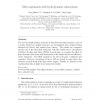Free Online Productivity Tools
i2Speak
i2Symbol
i2OCR
iTex2Img
iWeb2Print
iWeb2Shot
i2Type
iPdf2Split
iPdf2Merge
i2Bopomofo
i2Arabic
i2Style
i2Image
i2PDF
iLatex2Rtf
Sci2ools
115
Voted
MCM
2011
2011
Micro-swimmers with hydrodynamic interactions
The low-Reynolds number motions of Purcell’s three-link swimmer, and of a closely-related two-paddle swimmer, are investigated and compared using slender-body theory and resistive-force theory. The results are compared (in the case of the three-link swimmer) with the resistive-force calculations of Becker, Koehler and Stone (BKS). In particular, we examine the effect of hydrodynamic interaction and slenderness on the displacement and efficiency of the swimmers. The BKS analysis is, for the most part, confirmed and extended. However, deviations of up to 43% are found in cases where the swimmer propels itself with large stroke angles. Finally, we discuss recent experimental data in light of our numerical results. Key words: low Reynolds number, Purcellian swimmer, two-paddle swimmer, resistive force, slender body
Related Content
| Added | 14 May 2011 |
| Updated | 14 May 2011 |
| Type | Journal |
| Year | 2011 |
| Where | MCM |
| Authors | Greg Huber, Stephan A. Koehler, Jing Yang |
Comments (0)

